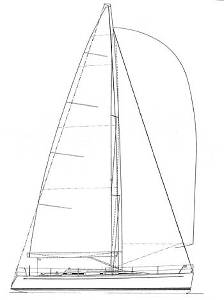Swan 45
Racer-cruiserr
By "moderate" I refer to displacement, which in this case is at the light end of moderate. Gentle reader, let me explain one more time in answer to the many letters that I get: "Displacement" and "weight" are the same thing. A boat displaces its own weight in water, and that's why we call it displacement. Since the 45 has a displacement of 19,510 pounds, it weighs 19,510 pounds. This weight (measured "light," i.e., without gear, crew, fuel or stores) gives the Swan a D/L of 140.2.
We have a curious mix here of IMS-style, short-ended hull shapes, with a heavier hull than is usually found on race-type boats. Look at the rocker forward and the way it dramatically curves up to the elevated and exposed forefoot knuckle. Also look at the way the Swan's rocker flattens out around the keel area.
Despite these differences I'd bet that if you plotted the longitudinal distribution of volume (i.e. the area curve) for the Swan and the Sweden you would find two similar curves. The water doesn't see two-dimensional hull shapes. It sees a volume moving through it. The skilled designer will work with a proven or promising volume/area curve and then shape the sections to get the most performance out of a given volume and DWL. This requires balancing the performance components to fit the desired overall personality of the boat.
Look at this unusual rudder shape. There is a definite, gentle S-curve to the leading edge. This may be a function of simply increasing the chord length at the top or "roof" of the rudder so that there is a thicker foil there to accommodate a bigger rudder stock. Whatever the reason, it sure looks odd. But then most advances in yacht design look odd when we first see them. The keel is an I-shaped fin and bulb. Draft is 9 feet, 2 inches.
I like the look of this boat. The sheer is flattish but goes well with the short ends. The cabintrunk is nicely sculpted. Nautor has never built an ugly Swan. The cockpit is arranged for racing with a big wheel and no coamings aft. Side decks are very broad. The mainsheet traveler is on the cockpit sole, where it should be. The mainsheet is double ended and leads to the winches just forward of the wheel. The open transom will work well for cruising.
Look at three of the four boats this month and you will see fractional rigs with swept spreaders. This is definitely the rig of the day. Big jibs are out and small jibs are in. Big mainsails with lots of roach overlapping the backstay are almost standard. On this rig the backstay is shown as a removable stay (dotted line) so that backstay loads will be taken by the mainsheet and the mainsail leach much of the time making the backstay redundant. Another drawing shows a backstay batten like on a Melges 24 to lift the stay away from the roach when tacking. It sounds scary but consider the sweep of the spreaders and the aft moment provided by the swept shrouds. The SA/D is 26.3. That's enough to keep you on your toes and the boat on its ear.
Clearly in the past Nautor has had a hard time deciding if its Swans were either fish or fowl. Usually they were "fowsh," not quite race boats and not quite cruising boats. With this 45 it appears that the company is making a strong move to the performance side while not ignoring comfort. Aesthetically Nautor has set the pace since the early '70s to the point where "Swan" has become almost a genre in itself. Swan quality is also legendary. I look forward to seeing the 45 in person.

Comments